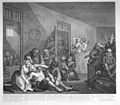Portal:Cartoon
The Cartoon Portal

A cartoon is a type of visual art that is typically drawn, frequently animated, in an unrealistic or semi-realistic style. The specific meaning has evolved, but the modern usage usually refers to either: an image or series of images intended for satire, caricature, or humor; or a motion picture that relies on a sequence of illustrations for its animation. Someone who creates cartoons in the first sense is called a cartoonist, and in the second sense they are usually called an animator.
The concept originated in the Middle Ages, and first described a preparatory drawing for a piece of art, such as a painting, fresco, tapestry, or stained glass window. In the 19th century, beginning in Punch magazine in 1843, cartoon came to refer – ironically at first – to humorous artworks in magazines and newspapers. Then it also was used for political cartoons and comic strips. When the medium developed, in the early 20th century, it began to refer to animated films that resembled print cartoons. (Full article...)

In print media, a cartoon is a drawing or series of drawings, usually humorous in intent. This usage dates from 1843, when Punch magazine applied the term to satirical drawings in its pages,[1] particularly sketches by John Leech.[2] The first of these parodied the preparatory cartoons for grand historical frescoes in the then-new Palace of Westminster in London.[3]

Sir John Tenniel—illustrator of Alice's Adventures in Wonderland—joined Punch in 1850, and over 50 years contributed over two thousand cartoons.[4]
Selected article -
Sam & Max is a media franchise focusing on the fictional characters of Sam and Max, the Freelance Police. The characters, who occupy a universe that parodies American popular culture, were created by Steve Purcell in his youth, and later debuted in a 1987 comic book series. The characters have since been the subject of a graphic adventure video game developed by LucasArts, a television series produced for Fox in cooperation with Nelvana Limited, and a series of episodic adventure games developed by Telltale Games. In addition, a variety of machinima and a webcomic have been produced for the series. The characters are a pair of anthropomorphic, vigilante private investigators based in a dilapidated office block in New York City. Sam is a calculative six-foot dog wearing a suit and a fedora, while Max is a short and aggressive "hyperkinetic rabbity thing". Both enjoy solving problems and cases as maniacally as possible, often with complete disregard for the law. Driving a seemingly indestructible black-and-white 1960 DeSoto Adventurer, the pair travel to many contemporary and historical locations to fight crime, including the Moon, Ancient Egypt, the White House and the Philippines, as well as several fictitious locations. The series has been very successful despite its relatively limited amount of media and has gathered a significant fan base. However, the franchise did not gain more widespread recognition until after the 1993 release of LucasArts' Sam & Max Hit the Road, which cultivated interest in Purcell's original comics. Sam & Max Hit the Road is regarded as an exceptional adventure game and an iconic classic of computer gaming in the 1990s. Subsequent video games and the television series have also fared well with both critics and fans; critics consider the episodic video games to be the first successful application of the episodic distribution model.
Selected character -
SpongeBob SquarePants is a fictional character in the animated television series SpongeBob SquarePants. He is voiced by Tom Kenny (pictured) and first appeared on television in the series' pilot episode "Help Wanted" on May 1, 1999. SpongeBob was created and designed by cartoonist Stephen Hillenburg shortly after the cancellation of Rocko's Modern Life in 1996. Hillenburg compared the concept to Laurel and Hardy and Pee-wee Herman. As he drew the character, he decided that a "squeaky-clean square" (like a kitchen sponge) fits the concept. His name is derived from "Bob the Sponge", the host of Hillenburg's comic strip The Intertidal Zone that he originally drew in 1989 while studying at the California Institute of Arts. SpongeBob is a naïve and goofy sea sponge who works as a fry cook in the fictional underwater town of Bikini Bottom. SpongeBob has achieved popularity with both children and adults, though he has been involved in public controversy.
Did you know... -
- ...that William Hanna claimed that the Tom and Jerry character Jerry Mouse was named Jinx in his first appearance while Joseph Barbera claimed that the mouse went nameless?
- ...that the Simpsons short Good Night aired April 19, 1987 on The Tracey Ullman Show and was the first ever appearance of the Simpson family on television?
- ...that the Sam Sheepdog and Ralph Wolf cartoons Sheep Ahoy, A Sheep in the Deep, and Don't Give Up the Sheep were censored by ABC to remove a dynamite stick, a smoke break scene, and a spanking scene respectively?
- ...that Sozin's Comet: The Final Battle, the two-hour finale for Avatar: The Last Airbender, was the most-watched cable television broadcast in the week of its transmission?
Selected list -
The episodes of The Bellflower Bunnies, a children's animated series based on the Beechwood Bunny Tales books by Geneviève Huriet, Amélie Sarn and Loïc Jouannigot. It debuted on TF1, a French television network, on 24 December 2001. The series is written by Valérie Baranski, and produced by Patricia Robert. The show centres on the adventures and exploits of the Bellflower family, a clan of seven rabbits who live in Beechwood Grove. The two adults in the family, Papa Bramble and Aunt Zinnia, take care of their five children: Periwinkle, Poppy, Mistletoe, Dandelion and Violette. The series has also been broadcast on CBC Television and TFO in Canada, KI.KA in Germany, Portugal's RTP in the Azores, and in several other countries. The show has fifty-two episodes: four in the first season, twenty-two in the second, and twenty-six in the third. In the entire series, thirteen are based directly on installments in Beechwood Bunny Tales, published by Milan Presse of France and Gareth Stevens in the United States; the rest are based on scripts by Valérie Baranski. Distributors in Europe, North America, and South Korea have released DVDs of the first two seasons.
General images -
Selected biography -
William Hanna (1910–2001) was an American animator, director, producer, and cartoonist, whose movie and television cartoon characters entertained millions worldwide for much of the twentieth century. Hanna joined the Harman and Ising animation studio in 1930 and steadily gained skill and prominence while working on cartoons such as Captain and the Kids. In 1937, while working at Metro-Goldwyn-Mayer (MGM), Hanna met Joseph Barbera. The two men began a collaboration that was at first best known for producing Tom and Jerry and live action films. In 1957, they co-founded Hanna-Barbera, which became the most successful television animation studio in the business, producing programs such as The Flintstones, The Huckleberry Hound Show, The Jetsons, Scooby-Doo, The Smurfs, and Yogi Bear. In 1967, Hanna-Barbera was sold to Taft Broadcasting for $12 million, but Hanna and Barbera remained heads of the company until 1991. At that time the studio was sold to Turner Broadcasting System, which in turn was merged with Time Warner, owners of Warner Bros., in 1996; Hanna and Barbera stayed on as advisors. Hanna and Barbera won seven Academy Awards and eight Emmy Awards. Their cartoons have become cultural icons, and Hanna-Barbera's shows have a global audience of over 300 million people.
Subcategories
WikiProjects
- Main projects
- Arts • Animation • Comics • Entertainment • Visual arts
- Related Projects
- Anime and manga • Biography • Film • Fictional characters • Media franchises • Music • Television • Video games
Selected quote -
Topics
- Comic book
- Comic strip
- Digital comics
- Graphic novel
- Mobile comic
- Motion comics
- Trade paperback
- Webcomic
- Animator
- Animation director
- Animation studios
- Animation film festivals
- Feature-length films
- Short films
- Television series
- Computer-animated films
- Stop-motion films
- Traditional animation
- Limited animation
- Rotoscoping
- Stop Motion
- Clay
- Cutout
- Graphic
- Model
- Object
- Pixilation
- Puppetoon
- Computer animation
- Flash animation
- PowerPoint animation
- SVG animation
- Cel-shaded animation
- Crowd simulation
- Morph target animation
- Motion capture
- Non-photorealistic rendering
- Skeletal animation
Things you can do

- Requested articles: Fenwick (comics), Khimaera (comics), Mutant Underground Support Engine, Bruce J. Hawker, Marc Dacier, Hultrasson, Frankenstein Comics, Dave Johnson (comics), Paco Medina, Dappere Dodo, New Adventures of the Space Explorers, Habatales, Musical Box, Foo-Foo (TV series), Bonne nuit les petits, The Adventures of Lariat Sam, More...
- Images and photos needed: Request images that are needed from Wikipedia requested images of comics and animation to included in each articles.
- Stubs: Work on stubs in articles in Comics and Animation stubs.
- Infobox: Add infobox that are needed from Category:Comics articles without infoboxes and Category:Animation articles needing infoboxes in articles.
- Deletion sorting: Please see the collection of discussions on the deletion of articles related to comics and animation - compiled by WikiProject Deletion sorting
Related portals
Associated Wikimedia
The following Wikimedia Foundation sister projects provide more on this subject:
-
Commons
Free media repository -
Wikibooks
Free textbooks and manuals -
Wikidata
Free knowledge base -
Wikinews
Free-content news -
Wikiquote
Collection of quotations -
Wikisource
Free-content library -
Wikiversity
Free learning tools -
Wiktionary
Dictionary and thesaurus
More portals
Sources
- ^ Punch.co.uk. "History of the Cartoon". Archived from the original on 2007-11-11. Retrieved 2007-11-01.
- ^ Adler & Hill 2008, p. 30.
- ^ "Substance and Shadow: Original Editorial Accompanying "Cartoon, No. I"". Victorian web.org. Retrieved 29 October 2023.
- ^ "Sir John Tenniel". National Portrait Gallery. Retrieved 26 August 2022.







































